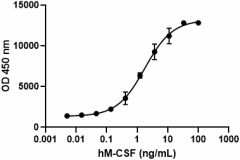- Regulatory Status
- RUO
- Other Names
- CSF1, CSF-1, MCSF, M-CSF, Colony Stimulating Factor 1, Macrophage Colony-Stimulating Factor 1, Colony Stimulating Factor 1 (Macrophage), Lanimostim

-

Recombinant human M-CSF induces proliferation of M-NFS-60 mouse myelogenous leukemia lymphoblast cells in a dose-dependent manner with an ED50 range of 0.75 - 3 ng/mL. -

Stability Testing for Recombinant Human M-CSF. Recombinant human M-CSF was aliquoted in PBS at 0.2 mg/mL. One aliquot was frozen and thawed four times (4x Freeze/Thaw), and compared to a control kept at 4°C (Control). The samples were tested in a proliferation assay with M-NFS-60 mouse myelogenous leukemia lymphoblast cells.
| Cat # | Size | Price | Quantity Check Availability | ||
|---|---|---|---|---|---|
| 790702 | 10 µg | $147.00 | |||
| 790704 | 25 µg | $229.00 | |||
Select size of product is eligible for a 40% discount! Promotion valid until December 31, 2024. Exclusions apply. To view full promotion terms and conditions or to contact your local BioLegend representative to receive a quote, visit our webpage.
M-CSF was first characterized as a glycoprotein that induces monocyte and macrophage colony formation from precursors in murine bone marrow cultures. M-CSF is constitutively present at biologically active concentrations in human serum. It binds CD14+ monocytes and promotes the survival/proliferation of human peripheral blood monocytes. In addition, M-CSF enhances inducible monocyte functions including phagocytic activity, microbial killing, cytotoxicity for tumor cells as well as synthesis of inflammatory cytokines such as IL-1, TNFα, and INFγ in monocytes. M-CSF induces RANKL production in mature human osteoclasts; consequently, M-CSF is a potent stimulator of mature osteoclast resorbing activity. Also, M-CSF induces VEGF in human monocytes in human tumors; high levels of M-CSF, mononuclear phagocytes, and VEGF are associated with poor prognosis in patients with cancer. High levels of M-CSF have been associated with different pathologies such as pulmonary fibrosis and atherosclerosis. M-CSF binds to its receptor M-CSFR, and this receptor is shared by a second ligand, IL-34. Human M-CSF and IL-34 exhibit cross-species specificity – both bind to human and mouse M-CSF receptors.
Product Details
- Source
- Human M-CSF, amino acid Thr32-Ser190 (Accession # P09603-3) was expressed in E. coli.
- Molecular Mass
- The 174 amino acid recombinant protein has a predicted molecular mass of approximately 20.2 kD. The DTT-reduced protein migrates at approximately 18 kD and and the non-reduced protein migrates at approximately 30 kD by SDS-PAGE. The predicted N-terminal amino acid is Thr.
- Purity
- >95%, as determined by Coomassie stained SDS-PAGE.
- Formulation
- 0.22 µm filtered protein solution is in PBS, pH 7.2
- Endotoxin Level
- Less than 0.1 EU per µg protein as determined by the LAL method
- Concentration
- 10 and 25 µg sizes are bottled at 200 µg/mL. 100 µg size and larger sizes are lot-specific and bottled at the concentration indicated on the vial. To obtain lot-specific concentration and expiration, please enter the lot number in our Certificate of Analysis online tool.
- Storage & Handling
- Unopened vial can be stored between 2°C and 8°C for up to 2 weeks, at -20°C for up to six months, or at -70°C or colder until the expiration date. For maximum results, quick spin vial prior to opening. The protein can be aliquoted and stored at -20°C or colder. Stock solutions can also be prepared at 50 - 100 µg/mL in appropriate sterile buffer, carrier protein such as 0.2 - 1% BSA or HSA can be added when preparing the stock solution. Aliquots can be stored between 2°C and 8°C for up to one week and stored at -20°C or colder for up to 3 months. Avoid repeated freeze/thaw cycles.
- Activity
- ED50 = 0.75 - 3 ng/mL as measured by the ability of the protein to induce proliferation of M-NFS-60 mouse myelogenous leukemia lymphoblast cells
- Application
-
Bioassay
- Application Notes
-
BioLegend carrier-free recombinant proteins provided in liquid format are shipped on blue-ice. Our comparison testing data indicates that when handled and stored as recommended, the liquid format has equal or better stability and shelf-life compared to commercially available lyophilized proteins after reconstitution. Our liquid proteins are verified in-house to maintain activity after shipping on blue ice and are backed by our 100% satisfaction guarantee. If you have any concerns, contact us at tech@biolegend.com.
Antigen Details
- Structure
- Disulfide-linked homodimer
- Distribution
-
Hematopoietic stem and progenitors, embryonic stem cells
- Function
- Cytokine that plays an essential role in the regulation of survival, proliferation and differentiation of hematopoietic precursor cells, especially mononuclear phagocytes, such as macrophages and monocytes
- Interaction
- Monocytes, macrophages, mononuclear phagocyte precursors, microglia, proliferating smooth muscle cells, umbilical vein endothelial cells, and breast cancer cell lines
- Ligand/Receptor
- M-CSFR or CSF1R (CD115)
- Bioactivity
- Measured by its ability to induce proliferation of M-NFS-60 cells
- Cell Type
- Embryonic Stem Cells, Hematopoietic stem and progenitors
- Biology Area
- Cell Biology, Cell Proliferation and Viability, Immunology, Stem Cells
- Molecular Family
- Cytokines/Chemokines, Growth Factors
- Antigen References
-
- Kawasaki ES, et al. 1985. Science. 230:291.
- Wei S, et al. 2010. J Leuko Biol. 88:495.
- Hodge JM, et al. 2011. PloS One. 6:e21462.
- Morandi A, et al. 2011. PloS One. 6:e27450.
- Erblich B, et al. 2011. PloS One. 6:e26317.
- MacDonald KP, et al. 2010. Blood. 116:3955.
- Gene ID
- 1435 View all products for this Gene ID
- UniProt
- View information about M-CSF on UniProt.org
